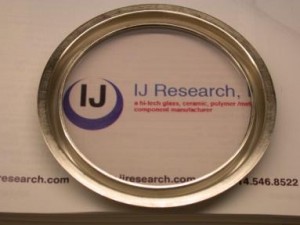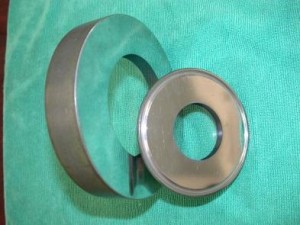Background
Glass to metal (GTM) sealing uses a vitreous glass, devitrifying glass or glass composite to form a hermetic seal. GTM seals can be formed using paste, preforms or dry frit powder.
Optical windows often use a sealing glass for hermeticity and dielectric properties. For some window caps, the window itself can be directly fused to the flange. The process requires heating the window glass beyond the softening point to the working range of the glass. The glass will flow to touch, wet and seal to the flange. Using a fixture, the result is a flat and smooth window cap assembly.
Matched vs. Compression Seals
For electrical feedthroughs, there are two types of seals. For a “matched seal”, the pin closely matches the glass and housing in terms of Coefficient of Thermal Expansion (CTE). A standard combination of materials for a matched seal is Kovar pin, Corning 7052 glass, and Kovar housing. This mitigates residual thermal stress that forms upon solidification and cooling of the assembly.
A “compression seal” uses a housing with relatively large CTE (Alloy 52 pin, Corning 9013 glass, SST housing). Upon cooling, the glass will be placed under radial compression. Compression seals are used in situations that require high mechanical strength. Historically, they are the predominant design for military feedthroughs.
IJ Research is a well-known manufacturer for GTM feedthroughs and optoelectronic assemblies since 1988. Over the years, IJ Research has gained experience for not only typical matched and compression seals, but also special sealing techniques where the common compression or match seal glasses are not appropriate. These areas include glass composites, devitrifying glass seals, and S-glass seals.


 Please see PDF brochures for Glass to Metal Seal, Hermetic seals and Sealing Glass List for more information.
Please see PDF brochures for Glass to Metal Seal, Hermetic seals and Sealing Glass List for more information.

